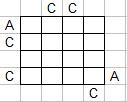John Smith has come up with a perfect plan to get rich: he is gonna auction dollar notes, but with a twitch. The dollar note will be won by the highest bidder, as usual, but the next highest bidder also has to pay his bid.
Now if you wonder how this is gonna make him money, let’s consider how an auction is likely to develop. It is obvious worthwhile to bid 1 cent, so someone will likely do that. It is also profitable to overbid this with 2 or 5 cents, so let’s say someone else will bid that. prices will go up. But a problem develops near the 100 dollar cent limit. Let’s say someone hits 98 cents. Someone else bids 99 cents. Then the person with the 98 cents bid will loose 98 cents unless he bids 100. And then the first person, who is about to loose 99 cent, is better off by a bid of 101 cent.
Now, how can you, as one of the bidders, outsmart John Smith?
Fellow consultant Con Diender was kind enough to buy me the booklett “Einstein’s riddle”, by Jeremy Stangroom. Though I think the title is not accurate – the zebra puzzle is a puzzle, not a riddle – it is an interesting collection of problems. The problem above was mentioned in this book, though the author gives an incomplete or incorrect answer.



